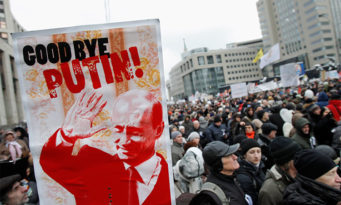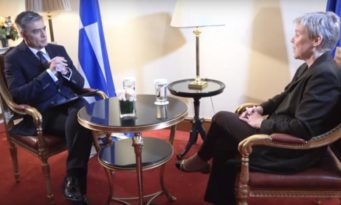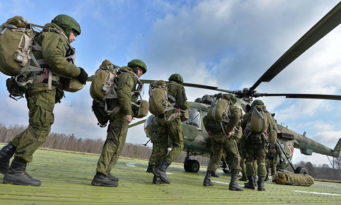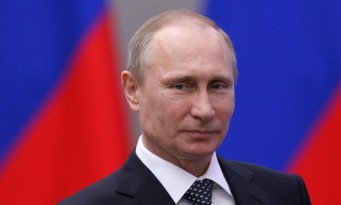The ISIL threat and the future of NATO in Afghanistan
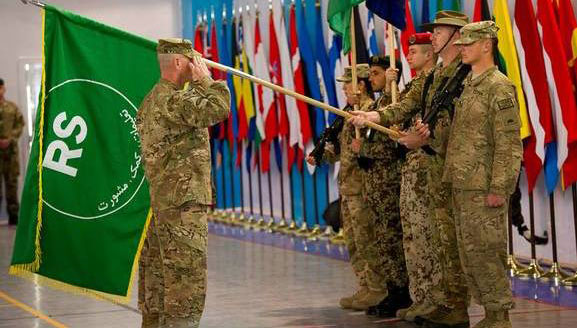
- By defencematters
Deputy Chief of Staff for Communication at the NATO Resolute Support mission in Afghanistan, BG Wilson Shoffner,talks about the ISIL danger, explains the current NATO mission and gives us some insight about the future of NATO in Afghanistan.
Eleni Panayiotou
The NATO Resolute Support mission is the new non-combat mission for NATO in Afghanistan after the departure of ISAF in December 2014. The mission has already been in place for a little over six months but there are some concerns as to how effective this mission is and whether in fact it was a bad time for ISAF to leave. Earlier this month, the National Directorate reported that ISIL leader Shahidullah Shahid was killed in an airstrike in eastern Afghanistan.
In a conversation with DefenceMatters, Deputy Chief of Staff for Communication at the NATO Resolute Support mission in Afghanistan, BG Wilson Shoffner, talks about the ISIL danger, explains the current NATO mission and gives us some insight about the future of NATO in Afghanistan.
Recent events show that ISIL is a very clear danger in the region. How are you dealing with this and is there any evidence that ISIL and the Taliban will join forces or the even more unlikely scenario that the Taliban and the Afghan government will co-operate in a bid to fight ISIS?
ISIL in Afghanistan clearly is a concern for president Ghani and that makes it a concern for us. It is a priority intelligence requirement for us and we are continually sharing intelligence and information with the Afghan government.
In terms of what we’ve seen so far concerning ISIL, we have seen that they have some but not a significant amount of financial support. We don’t believe they are operational in Afghanistan and by that we mean that they don’t have the ability to co-ordinate and to orchestrate operations around the country. We are working with the Ministry of Interior and the Ministry of Defence as well as other countries in the region on this as we do acknowledge that there is the potential for ISIS to spread here.
There clearly is some foreign influence in Afghanistan, which is nothing new, the presence of foreign fighters doesn’t necessarily alarm us. We clearly have seen some rebranding by Taliban and former Taliban with the expectation that they might have a better support of resources if they are branded as ISIL.
With regard to resources we haven’t seen a lot of of weapons and material flowing to ISIL but we have seen some fighting between ISIL and the Taliban particularly in the East and we are monitoring it closely. There are clearly some political differences that may be a motivation towards some of the fighting, but what we also see is that the Afghans want to stop the spread of ISIL even more so now.
President Ghani sees this as a regional issue, not limited just to Afghanistan, and wants to pursue a regional solution to combat the challenge of ISIL.
We consider ISIL a global threat and I would say that the Afghan government is concerned with both the Taliban and ISIL.
Are you concerned that Afghanistan is still without a Defence Minister?
The bottom line is that the president of Afghanistan has the authority he needs to run the Ministry of Defence. I think the Afghan national army has performed well despite the fact there’s been no Ministry of Defence nominee confirmed I think that fact reflects both the strength and the pride that’s in the force.
Was the departure of ISAF in December – in view of the ISIL threat - bad timing?
I would point out that in December the NATO mission changed it didn’t end. It’s not about the numbers it’s about what we are trying to do. So what NATO forces were doing in Afghanistan has fundamentally changed: we were focused on fighting at the tactical level while training and building the Afghan security forces. Coalition forces have stopped the fighting on a tactical level and are now almost solely focused on the train advice and assisting of afghan security forces.
ISAF has accomplished the role it has set out to do and now we have a new mission now and it’s appropriate that we changed the mission.
To put things in context with regard to the fighting that’s going on, the Afghan Security Forces had the lead in the last two fighting seasons and they are now fully in the lead with minimum support from the coalition forces, this means that we are now on the path which has been discussed consistently at various summits (Lisbon, Chicago and Wales).
Could the mission change again (back to combat)? And what does this current mission entail?
We don’t see any indication that it will change. A few years ago we had more than 140000 coalition forces in Afghanistan, today we have less than 10% of that and the Afghan security forces are doing reasonably well so we think the campaign remains largely on track so we don’t see any reason to change our force structure or the composition of our force.
Concerning the mission I think it’s appropriate to acknowledge the fact that 40 different countries are participating in this mission. It’s not just a US heavy role it’s a combined role. However we are aware that Afghanistan does remain a dangerous place and we cannot become complacent. Not surprisingly then force protection remains one of our top concerns.
We have Train Advise and Assist commands in four different regions in Afghanistan that are functioning fairly well. We have to be able to achieve the Train Advise and Assist role on a daily basis in order to be effective, this is what we call level one advising. This will continue with the Afghan security Forces to the end of this fighting season.
I do think that we have to have a continuous process of evaluation – both in evaluating ourselves and evaluating how the Afghan security forces are doing. This would result in a need to perhaps focus more or less in particular areas and prioritize our Train Advise and Assist effort based on that evaluation. I think the evaluation process would become even more critical as we look towards the transition period this coming Autumn and Winter and as we move from the Resolute Support mission to a new mission under NATO that would be the civilian led post-Resolute Support mission.
We believe that the Afghan Security Forces are capable of continuing to provide security for this country but it is going to take continued investment particularly as the Afghans get their economy back on its feet, this would take perhaps two to three years. I will point out that we haven’t seen a major terrorist attack - another 9/11 or another London or a Madrid - happen in Europe the USA coming out of Afghanistan and we think that this reflects the result of our combined efforts here.
Nevertheless there is a plan to reduce troops in Afghanistan. Do you think this is the right time to downsize?
The current plan has the troop level at about 12700 to spring of next year (2016). That’s the overall Resolute Support troop level. Perhaps what’s more important is that we are going to maintain troops throughout the remainder of this fighting season. We have started to work on a transition plan for 2016 but we are not sure what the new civilian lead NATO mission - post Resolute Support - would require. As far as the US security cooperation office is concerned we have a good strength of 1000 as our planning factor for 2017 but a lot of things have to be worked through to determine what it may finally look like.
We think that we have the troops that we need to do the mission that we have been asked to do and there are decisions to be made by NATO and other leaders to determine what the downsizing would look like.
So, you believe the mission has been a success so far?
Yes I do, and I would like to highlight the fact that we are on track to the timeline laid out at the Chicago and the Wales summit.







